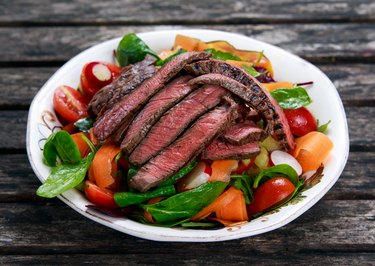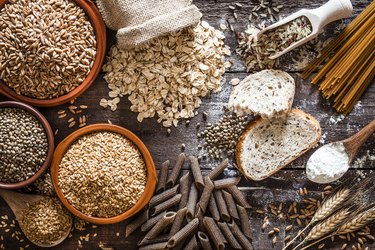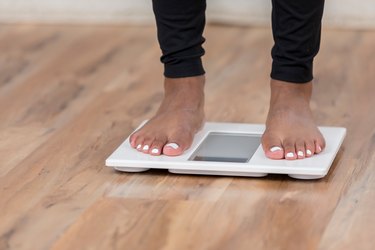
If a diet spectrum were to exist, you would think the animal-free vegan diet and the meat-loving paleo diet would live on opposite ends. But because diet culture is nothing if not ever-changing, it appears the two have come together to create the pegan diet.
How can these two polar opposites coexist within one diet, though? And perhaps more importantly, is going pegan healthy, and will it help you lose weight? Here's what you need to know before you commit.
Video of the Day
Video of the Day
What Is the Pegan Diet, Exactly?
The pegan diet is a mashup, or collaboration if you will, of the vegan and paleo diets. It appears to date back to 2014, when it was first mentioned in a blog post by Mark Hyman, MD, a celebrity functional medicine physician. He points out that elite athletes like Lebron James follow a paleo diet, while vegan Rich Roll completed five Iron Man competitions. And that each side, paleo and vegan, can point to a number of studies supporting that theirs is the "best" diet.
His solution and personal approach is to combine the two, forming the paleo-vegan diet plan.
What You Can Eat on the Pegan Diet — and What to Avoid
The tenets of the pegan diet claim to combine the healthier attributes of the two diets. For example, foods eaten on the pegan diet should have a very low glycemic load, meaning that they're low in sugars and refined grains. The diet also stresses "no chemicals additives, preservatives, dyes, MSG and artificial sweeteners."
So what can you eat, and what's literally off the table?
Foods Allowed
- Fruits and veggies: Focus on deeper colors and "the more variety the better"
- Fish: If you consume fish, it should be low in toxins and mercury
- Meat and poultry: Eat sustainably raised or grass-fed
- Healthy fats: Nuts, seeds, olive oil and avocados
- Eggs: Eat the entire thing, yolk and all
Supplements like vitamin D3 and omega-3s are recommended for almost everyone. Vitamin B12 is also recommended for vegans.
Foods to Limit or Avoid
- Dairy: Dr. Hyman believes that dairy leads to obesity and other chronic diseases
- Gluten: Completely avoid
- Grains: Gluten-free grains may be eaten only in limited amounts. The goal is to eat low-glycemic whole grains.
- Beans: Can be eaten in limited amounts. Dr. Hyman believes that beans increase blood sugar and that lectins (a protein found in beans) cause inflammation and decrease nutrient absorption.
- Vegetable oils: Completely avoid
The Pros and Cons of the Pegan Diet

The pegan diet gets some things right, but some of claims and dietary restrictions lack scientific backing. Let's break it down:
The Pros
1. Nixes processed foods: One of the biggest benefits of the pegan diet is that it cuts out a lot of the ultra-processed foods that currently make up the bulk of our diets (and have been linked to negative health effects). The foods allowed on the pegan diet are whole, minimally processed foods.
Read more: Trying to Lose Weight? This is the One Food Group You Should Probably Cut (No, It's Not Carbs)
2. Encourages fruits and veggies: The diet recommends eating a significant amount of fruits and vegetables — indeed, about 75 percent of your diet should be plants, according to the guidelines. As the Centers for Disease Control and Prevention points out, only 10 percent of Americans are actually meeting the current fruit and vegetable guidelines (1.5 to 2 cups of fruit per day, 2 to 3 cups of vegetables). So getting people to up their intake is definitely a win.
3. Advocates for eating more fish: There are similar findings to the above when it comes to seafood consumption. According to an August 2015 report from the United States Department of Agriculture, about 80 to 90 percent of Americans aren't eating enough seafood, which means we're likely missing out on crucial omega-3 fatty acids.
4. Promotes healthy fats: The pegan diet also puts the spotlight on healthy sources of fat like avocados and nuts, which can help lower triglyceride and LDL-cholesterol levels, per the American Heart Association.
The Cons
1. There's no science to back it up: The biggest issue is that there's no published research on the benefits of following a pegan diet. In fact, some of the foods the diet restricts, like whole grains and beans, are a big part of the Mediterranean diet, and there's a significant body of research backing the health benefits of that diet.
2. It could cause nutrient deficiencies: In fact, the 2015-2020 Dietary Guidelines for Americans lists 10 nutrients of concern (nutrients we're all falling short on), and whole grains and legumes are sources for half of these nutrients, including fiber, iron, vitamin A, magnesium and potassium. Nixing or limiting these foods could put you at risk for a deficiency.
3. It's overly restrictive: The diet eliminates gluten but not for valid concerns like celiac disease or gluten sensitivity. The reasoning is more in keeping with the caveman lifestyle and other theories that have yet to be validated by science.
Also, because this diet has so many food rules — what you're allowed to eat and what you should avoid — it could act as a trigger for someone with a history of an eating disorder and would not be recommended.
Can It Help You Lose Weight?

The short answer is yes. Why? One of the major reasons is because the majority of our diets, as in more than 70 percent, currently comes from ultra-processed foods, according to a study published July 2019 in Nutrients. The pegan diet, on the other hand, is rooted in whole, minimally processed foods, which have been shown to help support weight loss.
Case in point: A May 2019 clinical study published in Cell Metabolism tested the effects of two different diets in a controlled setting — an ultra-processed diet and an unprocessed diet. Despite being given the same amount of food (matched for calories), those on the ultra-processed diet naturally ate 500 calories more and gained about a pound after just two weeks. Those on the unprocessed diet, on the other hand, tended to lose the same amount of weight in that timespan. While this study was small, it built on a body of previous research linking processed foods to weight gain.
The difference between the unprocessed diet in that study and the pegan diet is the omission of whole grains and legumes. There's no need to cut out or limit healthy foods like whole grains and beans. Instead, make small changes in your diet to incorporate more fruits, vegetables and whole foods altogether while limiting ultra-processed foods, which are typically high in added sugar, saturated fat and sodium.
Looking for a healthier way to cut down on processed foods and lose weight? Try this seven-day meal plan to kickstart the Mediterranean diet.
- Dr. Hyman Blog: "Why I am a Pegan – or Paleo-Vegan – and Why You Should Be Too!"
- Centers for Disease Control: "Only 1 in 10 Adults Get Enough Fruits or Vegetables"
- United States Department of Agriculture: "Consumers Missing Out on Health Benefits of Seafood Consumption"
- American Heart Association: "The Facts on Fats Infographic"
- 2015-2020 Dietary Guidelines for Americans: "Underconsumed Nutrients & Nutrients of Public Health Concern"
- Nutrients: "The Healthfulness of the US Packaged Food and Beverage Supply: A Cross-Sectional Study"
- Cell Metabolism: "Ultra-Processed Diets Cause Excess Calorie Intake and Weight Gain: An Inpatient Randomized Controlled Trial of Ad Libitum Food Intake"